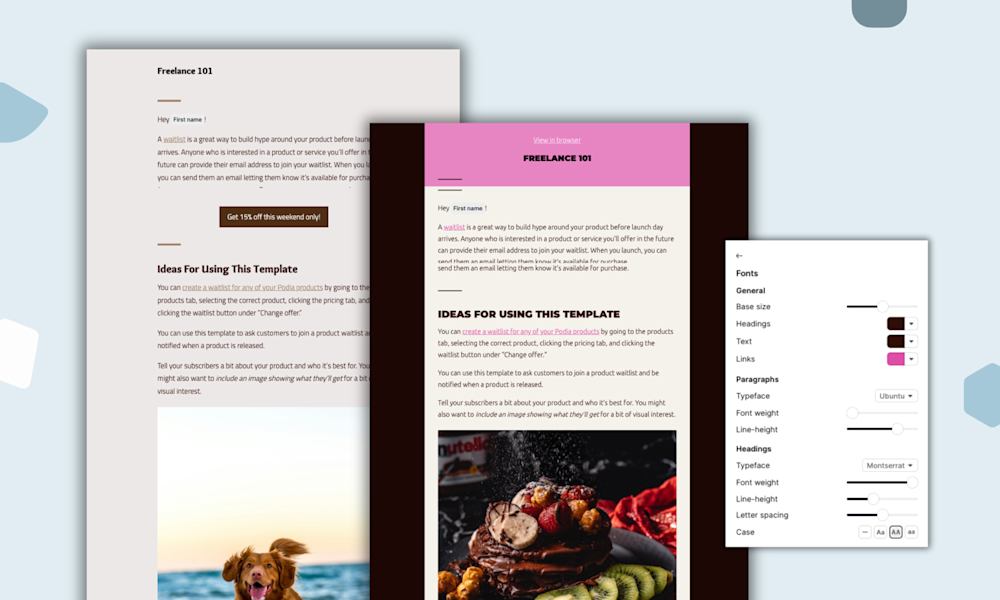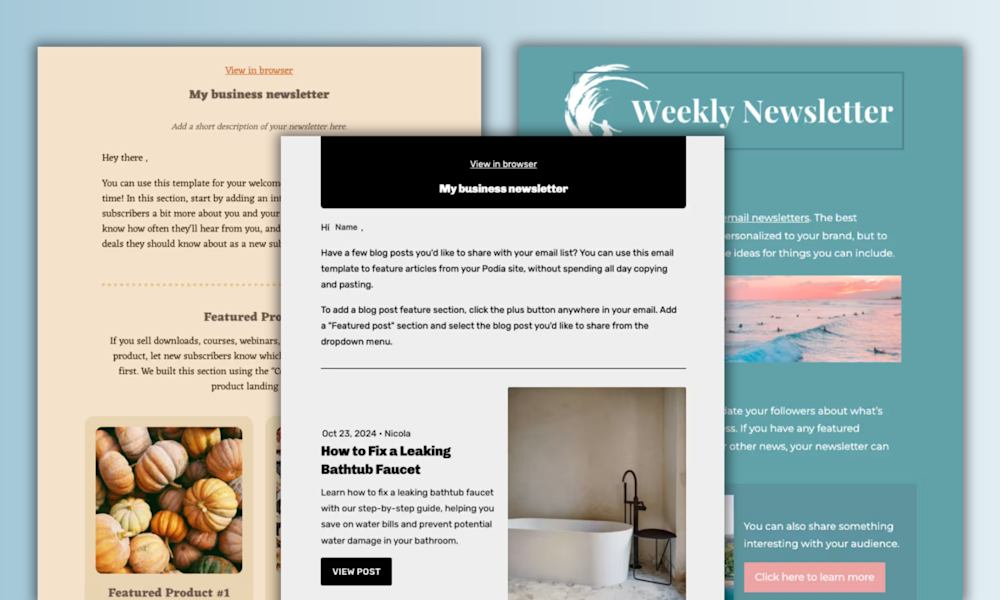Growing an email list is like growing a vegetable garden.
Without the proper care, your garden won’t produce any yummy greens to eat.
The same goes for your email list, except you’ll be missing the money kind of green.
If you’re a small business owner with a growing email list and want to earn more money online, you’re in the right place.
Today, we spill the beans on how to earn money from your email list without ever selling your precious emails.
More specifically, we’ll take you through five ways to monetize your email list that will help both your subscribers and your business.
5 straightforward ways to turn your email list into a profitable machine
#1. Offer a tripwire to your email subscribers
OK, so the name might remind you of espionage, but there’s nothing sneaky about using tripwires in email marketing -- if you do it the right way, anyway.
In case you’re unfamiliar, a tripwire is an inexpensive product that you offer your opt-in subscribers. The idea is, once they purchase your inexpensive tripwire, they’ll be hooked on your brand and inclined to purchase other products from your online business.
Check out this retro example of a tripwire from old-school Columbia House, where they offered cassettes for dirt cheap to get people in the door.
After people purchased Columbia House’s tripwire of 13 records or tapes for a mere $1, they were enticed to purchase even more great music from the label.
And that’s, ultimately, the purpose of a tripwire -- to get more customers into your sales funnel, so you can send them follow-up nurturing emails that nudge them to purchase more products from your brand.
Of course, it goes without saying that your tripwire needs to delight your purchasers.
One trusty way to impress your tripwire customers is to straight-up deliver a high-quality product and experience, no matter how inexpensive the tripwire is, or how low your profit margins are.
Why? They’ll feel connected to your brand.
And if you go the extra mile to connect your subscribers with your brand, you’ll be glad you did -- especially considering a whopping 93% of brands agree that consumers are more likely to spend with businesses they feel connected to.
So, treat your tripwire customers like VIP customers, let them know you truly care about them, and go out of your way to make them feel connected to you.
Keep this up for longer, and you’ll see your conversion rates go up even more.
Half of repeat customers make a repeat purchase within 16 days of their initial purchase.
And if you’re wondering how well tripwires (good ones) work, the answer is very.
Founder of KendraBLOGS, Kendra, enjoys a 46% conversion rate from her $7 digital download tripwire, which is a digital product that provides more profit than her $59 digital product.
All this to say, a low-cost tripwire may be the perfect appetizer to offer your email subscribers. If you truly help them solve a problem, and make them feel connected to your brand, they’ll likely become a super fan of your online business.
This makes selling to your subscribers a much easier task, even if they aren’t your own products -- which brings us to our next tip.
#2. Use affiliate marketing and promote affiliate products
If you’re a solopreneur or entrepreneur who’s crunched for time, promoting affiliate products to your email list might be the way to go.
Rather than having the pressure of creating and maintaining your own products, affiliate marketing lets you earn a percentage of the affiliate products that you sell.
Here’s how affiliate marketing basically works:
-
You partner with an affiliate marketing program
-
You promote and sell affiliate products to your email list
-
You earn a commission each time you sell an affiliate product
That’s the pay-per-sale affiliate marketing process, anyway. We’ll stick to this affiliate marketing format for simplicity’s sake.
One vital affiliate marketing tip is to offer products that are relevant and helpful to your email subscribers and credible products that you believe in. In fact, this goes for any of our suggestions for making money with your email list.
Even if it’s just providing your own list of favorite Amazon books to your email subscribers, your email content still needs to be relevant and help your email subscribers solve a problem or reach a goal.
Check out how The Podcast Host includes a link to an affiliate product, Bluehost, and mentions it as a tool to use for helping his email list audience reach their business goal.
Rather than promoting Bluehost in a standalone email, The Podcast Host incorporates the affiliate product nicely into his educational email content, which makes it a relevant affiliate product.
Follow in the footsteps of The Podcast Host, and you may be very pleased with this email monetization method.
So much so that well-crafted affiliate marketing programs can boost revenue by an impressive 30%.
On the other side of the coin, if you don’t send relevant info to your email subscribers, chances are they’ll unsubscribe from your email list. In fact, emails that aren’t relevant to subscribers is the second biggest reason why people unsubscribe from email campaigns.
If you’re looking for affiliate marketing programs to join, consider perusing some of these sites, which are among marketers’ favorite affiliate marketing networks:
In a nutshell:
Find an affiliate marketing program that aligns with your brand and audience. Then promote relevant affiliate products, in the context of valuable email content, to your subscribers.
An important sidenote: with any affiliate marketing or endorsement program, include a disclaimer that discloses your relationship with the brand you’re promoting, per FTC guidelines.
Disclaimers are super important in our next tip, too.
#3. Seek email sponsorships
Another profitable way email marketers monetize their email list is by partnering with outside organizations and brands in an email sponsorship.
Several brands with large email lists offer the opportunity to sponsor an email campaign.
The Financial Brand, for instance, lets you sponsor their email newsletter. And the eLearning Industry lets you purchase exclusive email blasts to their email list.
Even though you may not be as big of a brand as The Financial Brand or eLearning Industry, you can still leverage your email list -- especially if you’ve been providing valuable content to your email subscribers and building rapport and trust over time.
That’s not to say you should sell access to your list to just anyone. It’s important to brainstorm a list of brands that might benefit your audience in a complementary way.
If you think of yourself as an influencer -- or even a blogging entrepreneur who writes great articles on a certain topic -- your audience trusts you enough to help them within your area of expertise.
So, try to come up with a list of organizations and people that will help your email subscribers in a similar and complementary way. Then, contact your target list and propose an email sponsorship.
If you don’t think you have much pull here, think again.
37% of people ages 18 to 34 claim to trust a brand after seeing sponsored content from an influencer. And 63% of consumers trust what an influencer says about a business more than what the company says about itself, too.
The caveat here is similar to that of affiliate marketing -- be true to your audience’s needs and don’t be overly promotional.
Consider this email from Whole 30, which features Chipotle’s new Whole 30 diet-compliant menu items.
The email mentions how subscribers following the Whole 30 diet can benefit from the expanded food options at the restaurant, rather than exclusively promoting Chipotle’s new menu.
Basically, you’ve worked hard to earn your email subscribers’ trust, don’t ruin it with an irrelevant email campaign.
As for keeping your email sponsor happy, the key here is to track your deliverability and open rate metrics, so you can report back to your sponsor the success of their sponsored email campaign.
And here’s a pro tip: Test your sponsor email’s subject line, so you can optimize the email campaign’s open rate.
Most of the popular email service providers, like MailChimp, Benchmark, and ActiveCampaign, will let you A/B subject lines before sending your email campaign to the bulk of your email list.
This is great because there’s a lot riding on subject lines, given that 35% of email recipients open emails based on subject line alone, so it’s worth A/B testing your sponsor emails.
If you’re wondering about the average email open rate, it’s 21.33% for all industries.
Regardless of the metrics you provide your email sponsor, the moral here is to make sure your email sponsor and your email subscribers are a good fit. Send relevant helpful email campaigns that will benefit all parties involved.
Of course, don’t forget to do your due diligence and include any disclaimers, so your email subscribers know you’re getting paid for the sponsored email content.
If dealing with outside sponsors seems like a bit too much to align, our next tip might be right up your alley.
#4. Sell a webinar to your email list
Another effective way to make money online from your own list of email subscribers is to sell a valuable paid webinar to your subscribers.
Wondering what topic to cover in your webinar?
Do some quick customer research and ask your email subscribers what they want to learn more about. You can create a simple survey using tools like Typeform, Google Forms, or SurveyMonkey to capture their ideas.
And if you find that a lot of people don’t respond to your survey, hop on social media and comb through popular posts and comments. Scope out your best performing email campaigns to find the topics that resonate the most among your email list.
Regardless of how you conduct your research, your audience will lead you to the exact topic they want to learn about in your webinar.
From there, tailor your content to your audience’s needs, and then create and offer an educational webinar to your subscribers for a fee.
For live webinars, a key tip for selling webinars is to send emails all the way up until you go live with your webinar. 59% of registrations happen less than a week before the webinar, and 17% occur the day of your webinar, so capture those last-minute signups.
By the way, if you want a streamlined way to manage your email list and email campaigns, sell webinars, and run your online business, look no further than Podia. Start your 30-day free trial today.
Selling your webinar using Podia’s all-in-one dashboard is as easy as selecting “Product” from the “Create” drop-down menu...
Then naming your webinar and choosing “Webinar” from the modal popup.
From there, you can add YouTube Live or Zoom webinar links, plus instructions on how to enroll in your webinar.
After that, you just enter your webinar price (and payment plan, if you’d like).
Then, boom. Your webinar is for sale on your site. A total cinch, right?
All-in-one platforms aside, though, the main takeaway is to first find out what your email subscribers want to learn the most about.
Then, finesse your webinar content to help them solve that specific problem, and offer your paid webinar to your subscribers in an email sequence leading all the way up to your webinar time.
Another option is to offer your webinar as a freebie, and then upsell or cross-sell products to your webinar registrants -- our last topic today.
#5. Upsell and cross-sell products to your email subscribers
In the same way that upselling and cross-selling can convince customers to purchase more products during the checkout process, you can upsell and cross-sell through email, too.
The only difference is, rather than upselling and cross-selling on the checkout landing page, you’re offering extra products to segmented email lists with timed email sequences and tailored offerings.
Let’s say a segment of email subscribers has purchased entrepreneur Seth Mosley’s digital product, The Baby Steps Plan, which goes for $49.
Seth can upsell a higher-ticket product, like his Music Production Mastery online course, which costs $997 to enroll.
This upgrade in digital products makes sense since the next natural step from learning how to become a professional in the music industry is to implement a plan and become one. (Much easier said than done, I’m sure.)
Basically, for upselling, all you need to do is send a sales email sequence offering your segmented email list of customers special access to something upgraded.
Your upsell email can also encourage subscribers to upgrade from a free version of a product to a paid one.
Medium, for instance, uses an upsell email to outline all the benefits their email subscribers gain by upgrading to a paid plan.
Or make it a limited-time exclusive offer that nicely bundles two like-products.
Evernote uses this approach in their email sequence, where they encourage subscribers to both upgrade their plan and take advantage of a limited-time deal for an extra six months of the upgraded plan.
Contrary to what you might think, upselling to a higher-priced product doesn’t always have to mean including extra content, either. You just need to deliver a top-notch experience and service.
Consumers claim they’d pay up to 16% more for better service. And 68% of consumers would pay up to 15% more if they were guaranteed a better experience.
So, if you’re worried about having to create a fancy high-ticket digital product, try focusing on delivering more hands-on customer support or personalized onboarding as part of your upsell.
As for cross-selling, you can recommend products your subscribers might enjoy, based on what you know about them from email behaviors, personal interactions, and other customer data.
Take an online course, for example. You can send customers who purchased your online course an email cross-selling one-on-one coaching sessions to keep students accountable for reaching their goal.
This email from mattress company Casper is a solid cross-selling email, even though it promotes a service as a freebie. It spotlights the Casper Sleep Channel, which might complement a Casper mattress purchase.
Likewise, Methodical does a great job cross-selling coffee and coffee-related products within the same email, which might work wonders if they have a lot of people looking for coffee swag or a new brew.
The gist of it is this:
Upselling and cross-selling aren’t only for your checkout process. If you find ways to offer relevant products tailored to segments of your email list, email can be a great way to convince warm leads to make a purchase.
Blossom your business alongside your email list
You can expand your revenue streams using email marketing if you stay true to your email subscribers.
Here are five trusty -- and ethical -- ways to make money with your email list:
-
#1. Offer an inexpensive tripwire to your email subscribers as a way to connect them with your brand.
-
#2. Promote relevant affiliate products that will benefit your email subscribers.
-
#3. Partner with brands that align with your business and subscribers and ask them to sponsor email campaigns.
-
#4. Find out what your subscribers need the most help with. Then create and sell a paid webinar to your email list to help them solve a specific problem.
-
#5. Use upselling and cross-selling in your email campaigns as a way to offer helpful and relevant solutions to your email list.
Here’s to helping your bottom line and your email subscribers.



